Carbon-neutral is now becoming the new gold. Nowadays, an increasing number of businesses make commitments to becoming carbon neutral, net zero, or even climate positive. We may wonder, given that global behemoths like Google claim that they are the first business to eradicate their carbon footprint.
Although concepts like "carbon neutral," "net-zero," and "climate positive" have been around for a while, they have only recently been adopted by small businesses to large enterprises, mostly for popular marketing reasons. Innocent customers may be misled by the variety of terms and the ambiguity surrounding them. However, being open and honest about them could inspire companies to take greater initiative.
So what is the difference between carbon neutral and net zero? How do plastic companies take action to complete these environmental goals? Dive deeper into this throughout the below article.
1. What does carbon neutral mean?
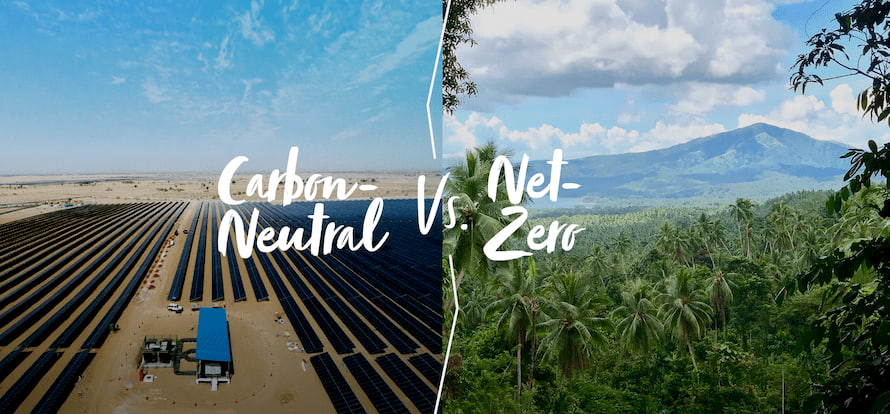
1.1. Carbon neutral definition
Carbon neutral, which was named the term of the year by the New Oxford American Dictionary in 2006, has now gained widespread acceptance. So what does carbon neutral mean? Carbon-neutral refers to a state in which the amount of carbon dioxide released into the atmosphere is equal to the amount of carbon dioxide absorbed by carbon sinks. Or simply, eliminate all carbon emissions altogether. Any system that absorbs more carbon than it emits, such as forests, soils, and seas, is considered a carbon sink.
The European Union Commission estimates that between 9.5 and 11 Gt of CO2 is absorbed annually by natural sinks. No man-made carbon sinks have been able to date to remove enough carbon from the atmosphere to stop global warming. As a result, businesses have two alternatives for being carbon-neutral: either dramatically decreasing their carbon emissions to net zero or balancing their emissions via offset and the purchase of carbon credits.
If we were to reach carbon neutrality, it would imply that we would no longer be adding to the greenhouse effect and would, as a result, not be inflicting any further harm to the climate of the Earth.
1.2. Carbon neutral does not mean carbon-free
Despite being often used interchangeably, the words "carbon-free" and "carbon-neutral" relate to different elements of climate action. Products, services, or businesses that are carbon-free do not produce any carbon emissions during production, delivery, or operation. This must apply to every step of the supply chain, including logistics, packaging, and all raw materials. In reality, there aren't any instances of carbon-free goods currently.
On the other hand, every business and any product may be carbon neutral since there are current criteria for calculating their emissions and approved carbon offset programs that businesses can fund to make up for the estimated emissions.
1.3. How does carbon neutral differ from climate neutral?
Both two terms "carbon neutral" and "climate neutral" refer to a company's greenhouse gas emissions being zero. Climate neutrality, on the other hand, goes a step further and takes the company's carbon impact from both upstream and downstream sources into account. This indicates that all emissions related to the firm are included, not just those from its own activities.
Since it's often simpler for businesses to cut their Scope 1 and 2 emissions than Scope 3 and 4 (in the Life Cycle Assessment - LCA process) emissions, carbon neutrality is more prevalent than climate neutrality. Certification for climate neutrality is considerably more demanding since it asks businesses to account for all of their emissions, not just direct ones.
1.4. Why is it important to be carbon neutral?
The increased emissions brought on by mass industrialism have caused a 2% increase in global temperatures over the last 50 years. Due to this, there have been more droughts, floods, and other adverse environmental effects, which have caused human misery, starvation, and death, as well as harm to animals. Therefore, it is crucial that we take action as a global society to reduce carbon emissions. Industry best practice in this regard is often seen as being carbon neutral.
Achieving "carbon neutral" emissions also supports a number of the UN's 2018 sustainable development goals, such as combating climate change and fostering sustainable cities and communities.
1.5. Becoming carbon neutral
Unless you live completely off the grid or power your business entirely with renewable energy, your carbon footprint almost certainly isn't zero. Calculators may be used to estimate your carbon footprint. You may also take steps to directly reduce or indirectly balance the carbon dioxide you discharge into the environment. By converting to renewable energy sources like wind, solar, or geothermal heating, as well as by choosing to bike or walk instead of drive, you may quickly reduce your carbon footprint.
Another alternative open to both people and businesses is investing in carbon offsets, which help programs to cut global carbon emissions (just not your own emissions). When you contribute money to a carbon offset project, you buy carbon credits. One metric ton of carbon dioxide is equal to one carbon credit. Since flying produces a significant amount of emissions, carbon offsetting for people often concentrates on the airline sector. Each passenger on a one-way flight from Chicago to New York City contributes around 630 pounds of carbon dioxide, or approximately one-third of a metric ton, to the atmosphere.
Other examples of carbon offset initiatives include agriculture management, wetlands restoration, and tree planting.
2. What does net zero carbon mean?
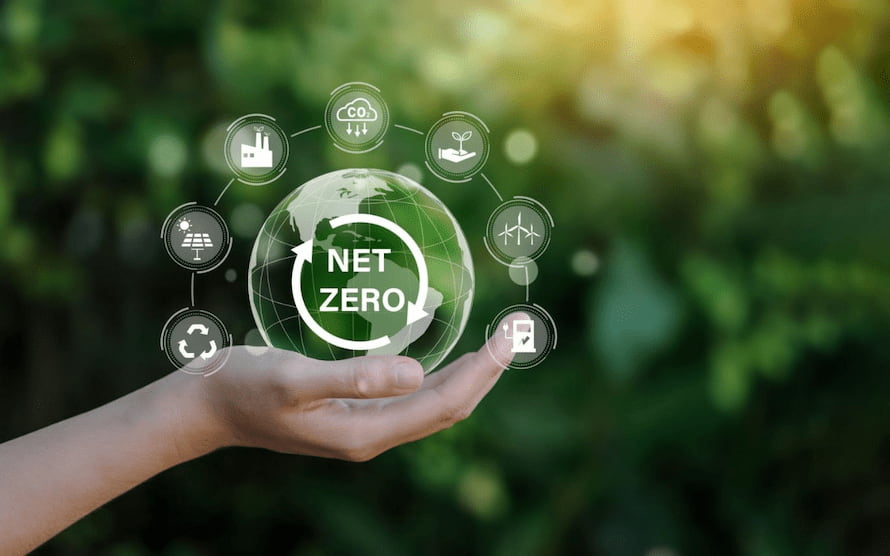
According to scientific evidence, the amount of greenhouse gasses produced by humans - like carbon dioxide - determines how much the planet warms overall. In order to stop catastrophic climate change, these greenhouse gas emissions must be reduced.
As a consequence, as part of the Paris Agreement, which was signed in 2016, countries from all around the globe agreed to strive to attain net zero emissions by 2050. The UK became the first significant economy to declare that it wants to achieve net zero by 2050.
2.1. Zero emissions definition
Net zero carbon means achieving a balance between greenhouse gas emissions created and emissions removed from the environment. Let's think of it as a set of scales: releasing greenhouse gas emissions tips the scales, and we want to bring the scales back into balance, which means no more greenhouse gas may be released into the atmosphere in a given year than is removed from it.
We'll probably need to tip them the other way eventually to undo the damage done. Even if we cease using fossil fuels, we will still have to deal with the emissions we have already sent into the atmosphere.
To reach the Net zero carbon goal, we must be able to emit some emissions and balance them with actions that decrease the number of greenhouse gasses currently present in the atmosphere. These can include initiatives like establishing new trees or drawdown strategies like direct air capture. The amount of carbon dioxide that must be removed from the atmosphere (via sequestration) in order to attain net zero increases as more emissions are created.
However, new greenhouse gas emissions must be as minimal as possible to prevent a climatic disaster. To put it another way, we should strive for a true zero and only use offsetting when it is absolutely required. This calls for a swift shift away from fossil fuels like coal, oil, and gas and toward renewable energy sources.
2.2. Benefits of net zero carbon emissions
In theory, net zero provides an accounting system to track progress toward a goal of climatic stability. A growing number of gamers may eventually commit to it as well.
According to a more thorough analysis, attaining net zero may also lessen the severity of local hydrometeorological disasters like drought and floods brought on by heavy rain. Events of drought may have an impact on food output, food quality and availability, wildfire danger, and land carbon sequestration. Up to two thirds less of the world's land area might be subject to aridification (a long-term rise in dry and hot conditions) if warming is kept to 1.5 degrees Celsius. By reducing the likelihood of flooding after big catastrophes worldwide, this goal may also assist to stabilize the natural environment.
From a business perspective, Net-zero enables the reduction of climate risk for shareholders without sudden interruption to near-term earnings, as well as reputational advantages for enterprises that cater to clients or are environmentally sensitive.
2.3. Why is net zero emissions important?
Once we cease utilizing fossil fuels, we won't be able to turn off the faucet on climate change. The primary cause of climate change, carbon dioxide, will continue to warm the world for a very long time since it will remain in the atmosphere.
Therefore, lowering greenhouse gas emissions is crucial, but we cannot stop there. The ultimate objective is to return the world climate to its pre-climate change levels by balancing the scales once again. To get there, we must cut greenhouse gas emissions to zero AND begin immediately to undo the damage done in the past by bringing down previous emissions.
2.4. What is the difference between Zero Energy and Net Zero?
Although the words "Net Zero" and "Zero Energy" are used in industry, they are not interchangeable since the two methodologies vary.
This entails finding other ways to balance the energy utilized on-site. In order to attain net zero, a project, for instance, would need to create 500,000 BTU of on-site renewable energy if it uses 250,000 kBTU of electricity and 250,000 kBTU of natural gas.
Zero energy is defined, in contrast, as the requirement of producing on-site as much renewable energy as it consumes in source energy. Both the energy required to generate the electricity or natural gas as well as the energy required to utilize it are included in this. This analyzes each energy source independently and takes into account elements like transmission loss and energy-generating efficiency. In this case, because their sources vary, one unit of electricity does not equate to one unit of natural gas.
Since net zero does not take into consideration variations in fossil fuels or the energy used in sourcing and delivery, it is less complicated and simpler to attain than zero energy. Additionally, as long as they are offset by other sectors, this permits certain industries (e.g. plastic manufacturing) to function with greater fuel use.
3. Carbon neutral vs net zero

What is the difference between carbon neutral and net zero? Are they similar? Although they are sometimes used synonymously, the words carbon neutral and net-zero really refer to quite distinct strategies for reducing carbon emissions and addressing climate change.
3.1. Does the difference between carbon-neutral vs. net-zero goals matter?
To stop climate disasters, it is critical to attain net-zero emissions. However, for many businesses, the definition of a net-zero or carbon neutrality commitment in a corporate setting is still ambiguous. And this uncertainty may hinder development.
You may be wondering whether a kind of decarbonization objective is preferable with the fast growth in businesses and governments establishing different types of decarbonization targets. And how can I choose the best decarbonization strategy for my business? Each organization will need to grasp the distinction between carbon-neutral and net zero in order to make a choice that is consistent with its values, risks, and degree of ambition. Not all climate objectives are created equal.
Let's examine the subtle differences between both concepts: carbon-neutral vs. net-zero goals and discuss why one may be preferable to the other for businesses hoping to have the biggest possible influence on the climate.
3.2. Different scopes
Going carbon neutral implies you may still create considerable emissions since there is no set threshold for emissions reductions.
Carbon neutrality only refers to Scopes 1 and 2 (your company's direct emissions), and it may apply to certain items and activities as well as your whole business. In conclusion, achieving carbon neutrality is a worthwhile short-term aim and a terrific place to start. However, even if every business switched to a carbon-neutral policy, it wouldn't be sufficient to prevent a 1.5° rise in world temperatures.
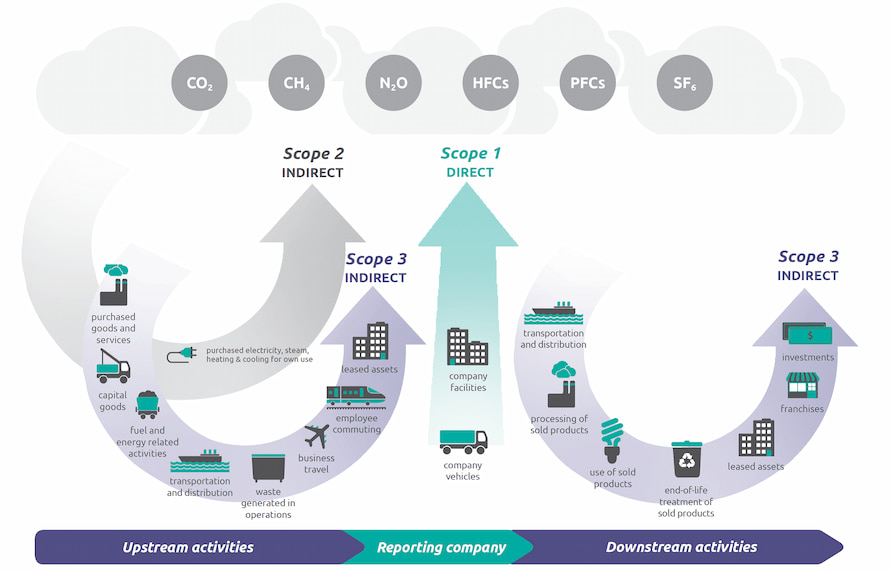
If you have a net zero designation, it signifies that you have employed all available technologies and exerted every effort to reduce your emissions as much as you possibly can before offsetting the remainder. GHG Scopes 1 through 3 are covered by net zero. However, scope 3 encompasses your company's whole value chain, from the supplies you buy to the end-of-life care for your goods, which is considerably more difficult to assess. Value chain emissions, also known as scope 3 emissions, are often the key to assisting an organization in achieving net zero emissions.
Although carbon neutral and net zero have similar definitions on the surface, their effects on the environment and degrees of acknowledged leadership in climate change are quite different.
In other words, corporate net zero is stronger in its definition and recommendations on how to decarbonize. Net-zero emission companies make a commitment to reduce their Scope 1, 2, and 3 greenhouse gas emissions to as little as practicable before (and only after) neutralizing any absolutely unavoidable residual emissions.
As a result, net zero, which refers to your company's overall operations, is more likely to be a long-term objective. To keep the rise in global temperature to less than 1.5°, we must all achieve net zero.
3.3. Unique standards and certifications
For reaching carbon neutrality and net zero, there are many international certifications and standards.
PAS 2060

If you follow the guidelines established by PAS 2060, you may get a carbon-neutral certification. The worldwide benchmark for carbon neutrality is PAS 2060. Companies must follow three steps in order to be considered carbon neutral:
- Count the total amount of carbon they emit.
- Set goals to reduce emissions (unfortunately, this is entirely up to the company, so this becomes essentially an ineffective standard).
- Buy carbon reduction credits (such as those from wind or solar farms) equal to their whole amount of emissions.
SBTi Net-Zero Standard
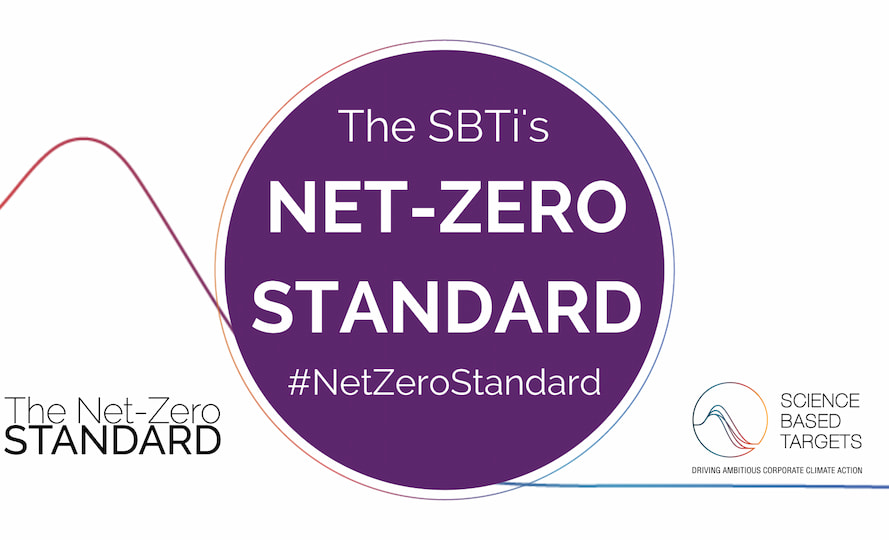
In the meanwhile, the SBTi announced its Net-Zero Standard in October 2021 (precisely in time for COP26), which was created to assist businesses in setting science-based goals to attain net zero. There are four main criteria for this standard (Science Based Targets initiative):
- A concentration on rapid, significant emission reductions. The majority of businesses will have to reduce their emissions by 90–95% to meet this criterion.
- Setting science-based goals for the short and long term. In actuality, this implies reducing emissions significantly in the near term, by 50% by 2030, and almost zero by 2050 (and neutralizing the remainder).
- Not making the claim of being net-zero until long-term objectives have been met (90–95 percent reductions in carbon emissions and offsets for removal of residual emissions).
- Increasing investments in climate change. Companies should explore funding climate change programs outside of their own activities (after first cutting and offsetting their own emissions).
3.4. Require different kinds of offsets
To become carbon neutral, you must offset your emissions in an amount equal to your emissions, although these offsets don't have to be anything more complicated than carbon reduction offsets.
Offsets for carbon emissions include initiatives like solar energy production and wind farms. These kinds of initiatives assist in reducing the overall volume of carbon dioxide emitted into the atmosphere, both now and in the future.
These initiatives are excellent for the environment, but since they don't really remove carbon from the atmosphere, they can't help us reach our less-than-1.5° objective by themselves. Additionally, they are often significantly less expensive than the carbon removal credits needed for net zero.
Net zero offsets, on the other hand, must be carbon removal offsets, which means that the carbon that is now in the atmosphere is really pulled out – mostly owing to carbon sinks. These types of offsets are substantially more costly and difficult to find due to the newness of carbon removal technologies (such as direct air capture and improved mineralization) and the length of time it takes for established forestry projects to be ready to be utilized for carbon removal (10+ years).
Additionally, they may cost up to 10 times as much as carbon offset certificates.
3.5. Should you strive for carbon neutral or net zero?
Aiming for carbon neutrality is a good place to start, and it is virtually the same as reaching net zero emissions if you approach it with the attitude of first lowering carbon emissions as much as you can before you start offsetting.
But after COP26, the phrase "net zero" gained popularity and is in line with the international target of keeping temperature increases under 1.5°C. Instead of referring to the operations of a single corporation, it alludes to a condition of human life that we could one day achieve.
It also emphasizes lowering emissions as much as humanly possible (usually 90–95%) and solely using offsets to reduce the little amount of carbon that is unavoidably present in the atmosphere.
Thus, we advise focusing on net zero rather than carbon neutral when implementing environmental adjustments at work. Since carbon neutrality is now the most attainable objective, it might be a wonderful starting point for achieving net zero objectives. In any case, you will be faring far better than most if you are going for one of them.
4. Plastic companies’ effort to achieve the future of net zero

In the last recent decades, growing media attention has been given to the environmental hazard posed by the plastic industry. Governments, businesses, and consumers have all taken notice of the issue and are taking regulatory or behavioral action to solve it. However, it is not immediately clear how plastics relate to climate change. Will the implementation of the net zero goal speed up the low-carbon transition?
The answer is YES. The implementation of the net zero goal is going towards the most 3 significant benefits:
- Demonstrating commitment to reducing GHG emissions.
- Increasing valuable low-carbon product portfolio.
- Contributing to reducing risks and difficulties when exporting products to other markets, such as reducing/avoiding carbon taxes.
4.1. Use renewable resources
The plastics business is the one that people are most aware of among all the sectors that need to transition to Net Zero. Plastics are a crucial component of daily life, whether it be in the form of a popular beverage, a shampoo bottle, or a container filled with takeout. However, using renewable resources in the plastics industry is not a simple matter. Although plastic recycling is still being done continuously "Almost 50% of all plastics ever manufactured have been made since 2000", the truth is that most plastic is still being wasted. Why?
A linear lifecycle
The most challenging issue to resolve is without a doubt how to develop a sustainable, ecologically friendly plastics sector from renewable resources. Plastics have always had difficulty with their linear lifespan, which is a process that has issues from beginning to end. The raw ingredients must first be extracted since plastics are petrochemicals produced by digesting non-renewable fossil fuels. Furthermore, the actual processing releases a significant quantity of greenhouse gases. Thirdly, since plastics are always single-use, customers often discard the item once it has served its purpose. This brings us to the last environmental issue: landfills are often where plastics end up.
A circular economy is needed
The World Economic Forum claims that switching from the linear economy to the circular economy is the only route out of the dead end. It envisions a solution that calls for the production of plastic from renewable resources. The WEF contends that it is not only desired but also feasible to extract carbon, the fundamental component of plastics, from renewable raw resources including trash, biomass, and even CO2. It mentions a group of experts from across the world whose study demonstrates that "net-zero emissions plastic may be produced using a mix of biomass, CO2, and recyclable trash (with an effective recycling rate of 70%)."
Making advances in using plastics and renewable resources
A lot of organizations and governments are working to examine current, sophisticated recycling systems to treat plastic waste from renewable resources. Although the usage of plastics made from renewable resources is not very widespread in Vietnam, there are leading companies engaged in intelligent plastic recycling. This may be seen as a favorable indication for a net zero objective.
In addition to turning to renewable resources, plastic companies are also constantly looking for ways to improve and invent new materials to reduce CO2 emissions.
TBM and the initiative to produce Limex paper from limestone

A Japanese startup called TBM has received billions of yen in investment with technology to make paper from limestone - a material that is "almost never exhausted" on earth, instead of using wood and water as the way to make traditional paper. According to TBM, it takes 100 tons of water to make one ton of ordinary paper, while the company's stone paper, known as Limex, requires no water. Instead of 20 trees, they needed less than a tonne of limestone and 200kg of polyolefin elastomer.
Nobuyoshi Yamasaki, the founder of TBM, thinks this is an answer to concerns about deforestation and lack of clean water when demand for paper is forecast to double by 2030.
Limex paper outperforms conventional paper in durability, water resistance, and less color fading over time. According to japan.go.jp, this paper has received positive feedback from the business community and government agencies. Limex paper can also replace ordinary paper and plastic. Just 5% of the world's paper consumed is made from limestone, we can save water equivalent to 220 million people's annual needs and reduce 20% less greenhouse gas emissions than conventional methods.
4.2. Join carbon neutral programs
When a company, product, or service precisely measures its greenhouse gas emissions and implements plans to control, lessen, and offset their effects, it has achieved "Carbon Neutrality" or "Carbon Zero."
These carbon neutral programs play a crucial part in accelerating the global transition towards Net Zero by allowing businesses to fully assume responsibility for their carbon emissions today while planning and implementing longer-term changes in tandem with national initiatives for decarbonization.
Leaders in technology like Google, for instance, assert that their investments in "high-quality carbon offsets" and efforts to "couple wind and solar electricity" have "wiped out" their carbon footprint.
It can be said that joining carbon neutral programs and organizations will help businesses build clearer and more systematic goals, and the commitments made will also encourage them to implement more actively.
4.3. Become members of sustainable organizations
Some reputable sustainable organizations you may be interested in:
.jpg)
TFS is an international, not-for-profit association whose secretariat is located in Brussels, Belgium. It is an organization of chemical companies that work together to build sustainable chemical supply chains, and regulations to meet society's needs and expectations for sustainable development.
TFS supports and coordinates the sustainability performance measurement of chemical companies and their suppliers. Results are shared with all TFS members, helping to drive efficiency and cost optimization while encouraging industry-wide collaboration and continuous improvement. Companies seeking membership must comply with Responsible Care and the UN Global Compact.
.jpg)
Founded in 1995, WBCSD is an organization that helps businesses transition to sustainable development. The main activities of the World Business Council for Sustainable Development are to share knowledge about sustainable development, promote the adoption of standards and tools, and generate joint advocacy input.
Companies wishing to participate in WBCSD need to bring a new project proposal for the initiative partnership, participate in at least two projects and commit to Net-Zero emissions (Scope 1 and 2) by 2050, co. resolution support for Scope 3.
A prime example: BASF's efforts to reduce CO2 emissions and move towards a net zero goal
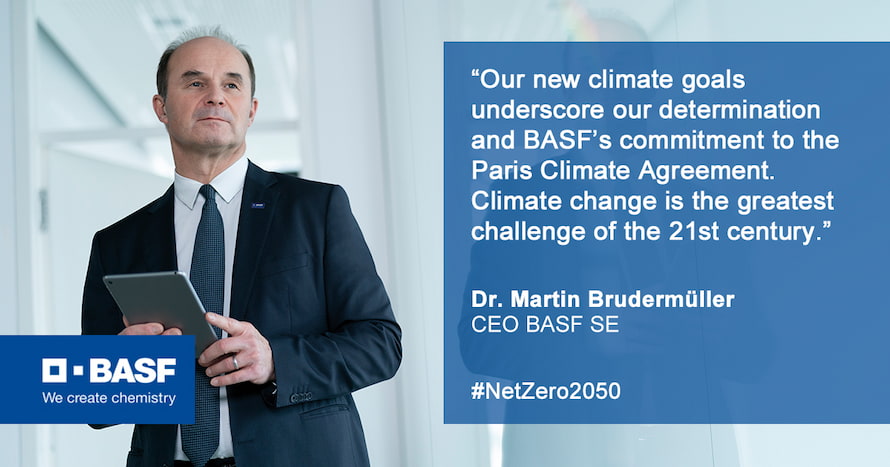
In its quest for carbon neutrality, BASF has set bold objectives and is working around the globe to achieve net CO2 emissions by 2050.
At the heart of the long-term transition towards net-zero CO2 emissions by 2050 is the use of new technologies, which will replace fossil fuels such as natural gas with electricity from renewable sources. Most of these technologies are being pioneered by BASF in collaboration with partners and are currently in beta. In addition, BASF will gradually turn to renewable sources to meet its electricity needs and intends to invest in wind parks to facilitate this.
BASF has therefore developed a unique digital system to quickly compute product-related cradle-to-gate carbon footprints (PCF) leveraging primary data, which complies with ISO14044, ISO14046, and other standards recognized by TÜV Rheinland. With the help of BASF's technology, the firm can not only give precise and detailed PCFs for its sales portfolio, but it can also generate an unprecedented level of transparency on the factors that influence its manufacturing footprint and raw material buying decisions
In addition, BASF participates in organizations and forums such as: Together for Sustainability (TfS), the World Business Council for Sustainable Development (WBCSD), and the World Economic Forum's Low-Carbon Emitting Technologies Initiative (LCET) to harmonize the methodological approaches used to calculate Scope 3 emission.